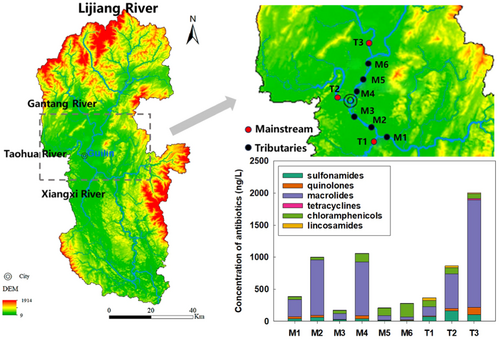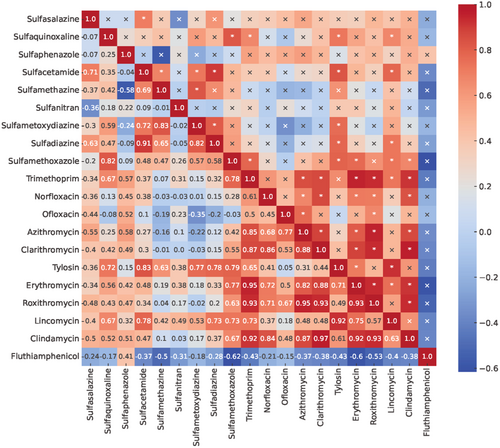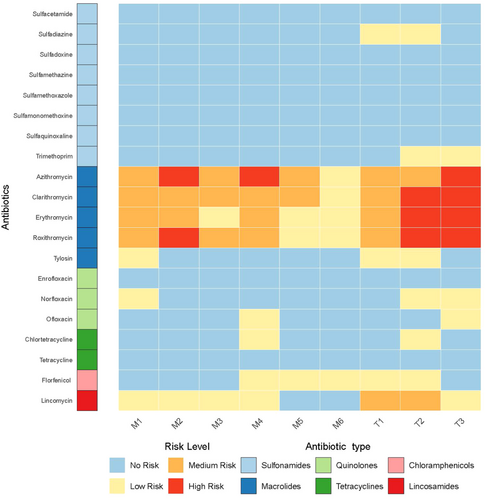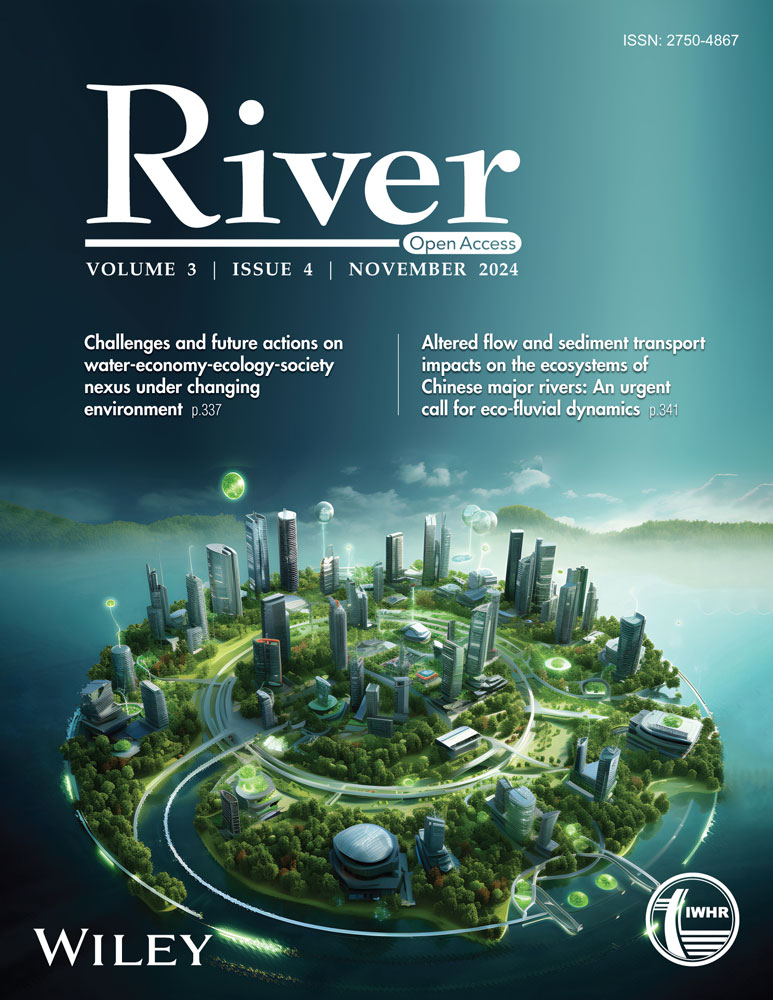Occurrence, ecological, and health risk assessment of antibiotics in water from the Karst River during influenza season
Abstract
The widespread use of antibiotics has significantly increased their presence in aquatic environments, particularly in sensitive Karst River systems. In this study, the distribution and ecological, human health, and resistance selection risk assessment of 44 antibiotics in the typical Karst River, Lijiang River, were investigated during the influenza season, a period marked by heightened antibiotic usage. 27 antibiotics could be found in the water of Lijiang River, among which azithromycin showing the highest concentrations. The concentrations of total antibiotics were in the range 171.70–2003.75 ng/L, with an average value of 704.76 ng/L. Macrolide was the predominant class, constituting an average of 57.65% of the total antibiotic concentrations. Risk assessments revealed that certain antibiotics, especially macrolides, posed moderate to high ecological risks to algae, displayed potential human health risks at low levels and contributed to antimicrobial resistance. Among all the antibiotics, azithromycin was the only one could cause ecological risk to algae, human health risk towards infants and antimicrobial resistance selection risk, which should be identified as the priority antibiotic for control in the Lijiang River during the influenza season. There was no difference in the concentrations, human health and antimicrobial resistance selection risk of antibiotics between mainstream and tributaries of Lijiang River. This study contributes to a better understanding of antibiotic pollution and provides insights into potential risk management practices in vulnerable aquatic systems worldwide.
1 INTRODUCTION
Antibiotics have been widely used in medical treatment, animal husbandry, and aquaculture since the discovery of antibiotics in the 1920s (Aminov, 2017; Defoirdt et al., 2011). The antibiotic consumption rates of human ranged from 5.0 to 45.9 defined daily doses per 1000 population per day in 2018, which increased by 46% compared to 2000 (Browne et al., 2021). It is also predicted that 107,472 tons of antimicrobials in animals could be consumed annually in 2030, especially in Asia (Mulchandani et al., 2023). The wide use and abuse of antimicrobials leads to a large amount of antibiotics discharged into the environment. Certain antibiotics have been proved to induce negative effects on survival rate and biochemical activities to algal species in aquatic environment, particularly sensitive blue-green algae (Guo et al., 2015, 2016; Zhang et al., 2023). Besides, low concentrations of antibiotics, even below the minimal selective concentration in the aquatic environment can also cause the selection and spread of antibiotic resistance genes (Bengtsson-Palme & Larsson, 2016; Stanton et al., 2020; Zhang et al., 2021c). Therefore, it is important to understand the pollution level and possible ecological, human health, and resistance selection risk of antibiotics in the environment.
Rivers, as receptors for municipal sewage, industrial and agricultural pollution, play a key role in the transport and diffusion of antibiotics at a watershed level (Couperus et al., 2016; Zhang et al., 2020a). A total of 169 different antibiotics and their metabolites have been found in global rivers across all seven continents, among which sulfamethoxazole, trimethoprim, and ciprofloxacin were found to have the highest detection frequencies and concentrations (Li et al., 2022a; Wilkinson et al., 2022). In the seven major rivers of China (Yangtze River, Yellow River, Huai River, Hai River, Liao River, Songhua River, and Pearl River), the highest concentrations of antibiotics such as sulfamethoxazole, roxithromycin, enrofloxacin, and ciprofloxacin were found to exceed 200 ng/L (Yin, 2021).
Karst rivers, particularly vulnerable due to their unique hydrogeology, have been also polluted by antibiotics. For example, in a Karst River of Guizhou Province, China, the total concentrations of antibiotics were in the range 96–1097 ng/L, composing by quinolones, macrolides and lincomycin (Zhang et al., 2021a). Seasons are also important to understand the occurrence and distribution of antibiotics in rivers. Winter was usually found to exhibit high concentrations of antibiotics compared to summer and autumn, which could be due to the increase use of antibiotics during the influenza season (Cao et al., 2024; Wang et al., 2022). Therefore, the distribution and health risk of antibiotics in Karst River during the influenza season should be given more attention.
The Lijiang River is not only a typical renowned Karst River for its scenic beauty, but also provides water source for Guilin City with millions of citizens (Xiao et al., 2021). However, the river has been polluted by heavy metals and microplastics, due to the tourism, fish farming, agricultural and industrial activities (Deng et al., 2021; Zhang et al., 2021b). To the best of our knowledge, the antibiotic pollution of the Lijiang River was less studied. In this study, the sampling sites along the Guilin reach of Lijiang River and three tributaries were set during the influenza season to understand the distribution and pollution level of 44 antibiotics. Ecological, human and resistance selection risk of antibiotics in the Lijiang River were also applied to give a comprehensive profile of antibiotics. Our results will be beneficial for understanding the pollution level and potential risk of antibiotics in the Karst River.
2 MATERIALS AND METHODS
2.1 Sampling sites and samples collection
The influenza season in China always occurs from December to March of the following year. Guilin is the largest city along the Lijiang River and has the greatest impact on the water quality of this river. Therefore, nine sites were set around the Guilin reach of Lijiang River, including six sites in the mainstream, and three sites in the tributaries (Xiangsi River, Taohua River, and Gantang River) (Figure 1). The geographical coordinates of sampling sites could be found in Table S1. Water samples were collected in Lijiang River, a typical Karst River, on 15th February, 2024. At each site, 1 L of water was collected and stored in a 1 L brown bottle with addition of 150 mg ascorbic acid and 0.25 g disodium ethylenediaminetetraacetate. Immediately after collection, the pH of the sample was adjusted to 2 by the addition of hydrochloric acid solution on-site. The collected samples were transported under cool and dark conditions.

2.2 Extraction and analysis of antibiotics
The collected water samples were mixed and passed through a solid-phase extraction with HLB cartridges (6 mL, 200 mg), according to previous methods (Zhang et al., 2024). Briefly, the water samples were passed through the activated column at a flow rate of 10–15 mL/min. The column was then rinsed with 5 mL of deionized water and dried for 20 min under nitrogen gas. Methanol (10 mL) was then used to elute the column at 5 mL/min, collecting the eluate. This eluate was concentrated to near dryness by nitrogen blow-down, reconstituted to 1.0 mL with the initial mobile phase, and filtered through a 0.22 μm organic membrane filter for analysis.
A total of 44 antibiotics were determined via high-performance liquid chromatography tandem mass spectrometer (LCMS-8050) (Shimadzu), encompassing 21 sulfonamides (including trimethoprim), 5 macrolides, 8 quinolones, 4 tetracyclines, 4 chloramphenicols and 2 lincosamides, according to previous methods (Chen et al., 2022; Liang et al., 2020). The limits of detection and recoveries for the 44 antibiotics were in the ranged 0.1–1 ng/L and 64.6%–113%, respectively (Table S2).
2.3 Ecological, human health risk, and resistance selection risk of antibiotics
Here, the acceptable daily intake (ADI) is defined as the level considered not to cause any adverse effect on an exposed population (Table S3). Body weights and drinking water intakes, corresponding to the 50th percentile for various life stages. The detail information could be found in the risk assessment of antibiotics for drinking water (Zhang et al., 2024). It was assumed that both the hazard quotient (HQ) and the gastrointestinal absorption rate (AB) equal 1, and the frequency of exposure (FOE) was represented by the detection frequency in this study.
Based on their RQ values, the ecological, human health and resistance selection risks were categorized into three levels: low risk (0.01 ≤ RQ < 0.1), medium risk (0.1 ≤ RQ < 1), and high risk (RQ ≥ 1) (Chen et al., 2022; Hernando et al., 2006; Li et al., 2018).
2.4 Statistical analysis
The heatmap of antibiotics based on Spearman correlations were calculated and visualized via corrplot package in R software (Wei et al., 2017). Welch's t-test was applied to analyze the difference in the concentrations and risk of total antibiotics between mainstream and tributaries, with statistical significance set at p < 0.05.
3 RESULTS
3.1 Concentrations and correlation of antibiotics in the Lijiang River, typical Kast River during influenza season
Among the 44 antibiotics, 17 (including 8 sulfonamides, 5 quinolones, 3 chloramphenicols, and 1 tetracycline) were not detected in any samples and 27 of were detected in the water of Lijiang River. For all the five types of antibiotics, macrolides were found in the range 42.47–1674.30 ng/L with the highest average concentrations (502.69 ng/L) (Figure 1), followed by chloramphenicols (94.95 ng/L), sulfonamides (58.98 ng/L), quinolones (32.22 ng/L), lincosamides (12.88 ng/L), and tetracyclines (3.05 ng/L).
Sulfadiazine, sulfamethoxazole, trimethoprim, ofloxacin, azithromycin, clarithromycin, erythromycin, roxithromycin, lincomycin, clindamycin, and fluthiamphenicol were all observed with 100% detection frequency (Table 1). Azithromycin in water of Lijiang River was found in the range 37.98–1483.89 ng/L, with highest average value of 425.83 ng/L. Fluthiamphenicol (94.95 ng/L), trimethoprim (37.76 ng/L), roxithromycin (34.22 ng/L), ofloxacin (24.65 ng/L), erythromycin (23.70 ng/L), sulfadiazine (16.09 ng/L), and clarithromycin (14.43 ng/L) in the water of Lijiang River were all above 10.0 ng/L during influenza season. For the Spearman correlation analysis, sulfaphenazole, sulfanitran, and fluthiamphenicol did not showed any correlations with other antibiotics (Figure 2). Erythromycin, sulfacetamide, roxithromycin, trimethoprim, sulfamethoxazole, azithromycin, clarithromycin, tylosin, lincomycin, clindamycin showed positive strong correlations with at least six other antibiotics.
| Antibiotics | Average | Min | Median | Max | DFa | CVb |
|---|---|---|---|---|---|---|
| Chloramphenicols | ||||||
| Florfenicol | 94.95 | 36.67 | 93.98 | 211.06 | 100.00 | 57.39 |
| Macrolides | ||||||
| Clarithromycin | 14.44 | 1.29 | 8.52 | 34.63 | 100.00 | 89.36 |
| Erythromycin | 23.70 | 1.42 | 13.33 | 70.03 | 100.00 | 110.94 |
| Roxithromycin | 34.22 | 1.79 | 27.49 | 84.78 | 100.00 | 93.80 |
| Azithromycin | 425.83 | 37.98 | 210.88 | 1483.89 | 100.00 | 114.27 |
| Tylosin | 4.50 | 0.00 | 0.98 | 23.40 | 55.56 | 173.83 |
| Lincosamides | ||||||
| Lincomycin | 8.29 | 0.42 | 1.21 | 44.28 | 100.00 | 178.44 |
| Clindamycin | 4.59 | 0.54 | 2.73 | 12.01 | 100.00 | 90.33 |
| Sulfonamides | ||||||
| Sulfadiazine | 16.09 | 1.19 | 5.68 | 86.69 | 100.00 | 172.13 |
| Sulfasalazine | 1.60 | 0.00 | 0.69 | 5.03 | 55.56 | 128.71 |
| Sulfamethoxazole | 0.59 | 0.12 | 0.28 | 1.90 | 100.00 | 101.56 |
| Sulfaquinoxaline | 0.09 | 0.00 | 0.09 | 0.29 | 55.56 | 116.85 |
| Sulfamethazine | 0.80 | 0.00 | 0.21 | 2.85 | 77.78 | 120.22 |
| Sulfamonomethoxine | 0.24 | 0.00 | 0.00 | 1.54 | 33.33 | 214.34 |
| Sulfadoxine | 0.08 | 0.00 | 0.00 | 0.26 | 44.44 | 132.19 |
| Sulfametoxydiazine | 0.53 | 0.00 | 0.39 | 1.34 | 88.89 | 80.16 |
| Sulfamoxole | 0.14 | 0.00 | 0.00 | 0.55 | 44.44 | 143.56 |
| Sulfaphenazole | 0.14 | 0.00 | 0.12 | 0.34 | 55.56 | 107.22 |
| Sulfacetamide | 0.49 | 0.00 | 0.37 | 1.64 | 55.56 | 119.00 |
| Sulfanitran | 0.45 | 0.00 | 0.39 | 1.12 | 77.78 | 81.50 |
| Trimethoprim | 37.76 | 8.35 | 28.15 | 102.39 | 100.00 | 81.52 |
| Fluoroquinolones | ||||||
| Ofloxacin | 24.65 | 4.28 | 11.61 | 93.42 | 100.00 | 116.71 |
| Norfloxacin | 7.44 | 0.00 | 3.07 | 22.11 | 77.78 | 118.47 |
| Enrofloxacin | 0.12 | 0.00 | 0.00 | 0.43 | 44.44 | 135.45 |
| Tetracyclines | ||||||
| Doxycycline | 2.67 | 0.00 | 0.00 | 24.02 | 11.11 | 300.00 |
| Tetracycline | 0.05 | 0.00 | 0.00 | 0.44 | 11.11 | 300.00 |
| Chlortetracycline | 0.33 | 0.00 | 0.00 | 1.23 | 33.33 | 160.56 |
- a Detection frequency.
- b Coefficient of variation.

3.2 Distribution of antibiotics in the Lijiang River, a typical Kast River
For the sampling sites along the mainstream and tributaries, 16–24 antibiotics were detected at each site. The concentrations of total antibiotics ranged from 171.70 ng/L (M3) to 2003.75 ng/L (T3) (Figure 1). The average values of all sampling sites were 704.76 ng/L. Macrolides accounted for more than 50% of concentrations of total antibiotics at most sampling sites, except for M5, M6, and T1. The average concentrations of total antibiotics in the mainstream and tributaries were 517.93 and 1078.42 ng/L, respectively. However, there were no significant differences in the concentrations of total antibiotics between the mainstream and tributaries (p > 0.05).
3.3 Ecological risk assessment of antibiotics in the Lijiang River, a typical Kast River
It could be found that the eight antibiotics did not show ecological risk to the algae at any sampling sites (Figure 3). However, the azithromycin, roxithromycin, erythromycin, and clarithromycin at all sampling sites could induce low to high ecological risk to the algae. Tylosin, trimethoprim, sulfadiazine, ofloxacin, norfloxacin, lincomycin, florfenicol, and chlortetracycline exhibited low or medium ecological risk to algae at some sampling sites. At the whole level, the sum ecological risk of antibiotics to algae at all sampling sites was in the range 0.25–8.20, with six sampling sites exceeded 1.0. These results indicated that at the whole level, antibiotics posed medium and high risk to algae. Although three tributaries all exhibited high sum ecological risk of antibiotics, but there was no significant difference in the sum ecological risk of antibiotics between the mainstream and tributaries (p > 0.05). For the ecological risk to crustacean (mainly Daphnia magna), the antibiotics in the water of Lijiang River did not exert any risk at the individual or the sum level (Table S4).

3.4 Human health and resistance selection risk assessment of antibiotics in the Lijiang River, a typical Kast River
For the human risk exposed to antibiotics, clarithromycin, roxithromycin, and azithromycin have an average risk value more than 0.01, which could pose a low risk towards infants with age of 0–3 and 3–6 months. All the sampling sites with values of the sum human risk of antibiotics more than 0.01, among which the four sites (M2, M4, T2, and T3) had values more than 0.1, indicated low and medium risks of antibiotics in the Lijiang River directly exposed to human via drinking if without any treatment (Tables S5 and S6). There was no significance in the human health risk between the mainstream and tributaries (p > 0.05).
For the resistance selection risk of antibiotics, it showed that azithromycin exhibited medium and high selection risk for antimicrobial resistance (Figure 4). Florfenicol and trimethoprim could induce low and medium selection risk for antimicrobial resistance in the water of Lijiang River. For the resistance selection risk of total antibiotics, the risk values of all sampling sites were in the range 0.31–6.72, among which five sites exceeded 1.0. These results indicated that the resistance selection risk caused by antibiotics could not be ignored in the Lijiang River. There was no significance in the human health risk between the mainstream and tributaries (p > 0.05).

4 DISCUSSIONS
In this study, we found that Lijiang River, a typical Karst River, has been experienced antibiotic pollution. The average concentrations of total antibiotics in the tributaries were higher than those in the mainstream; however, the difference was not statistically significant. This can be attributed to the fact that both the tributary and mainstream sampling sites are all located within the urban area of Gulin City, likely exposed to similar anthropogenic sources of contamination. The concentrations of total 27 detected antibiotics for all sampling sites ranged from 171.70 to 2003.75 ng/L, with an average value of 704.76 ng/L, which was higher than those in another Karst River of Guiyang (96–1097 ng/L) (Zhang et al., 2021a), Karst plateau wetland (21.8–954 ng/L) (Guo et al., 2022). Two reasons could be accounted for this phenomenon: (1) studied sites are mainly around the Guilin City with intensive human activities; (2) the winter flu season is the peak period for antibiotic use.
Azithromycin in the Lijiang River (37.98–1483.89 ng/L) was comparable to that in Mijares River (ND-1600 ng/L) (Fonseca et al., 2020) and higher than that in Neijiang River (ND-56.2 ng/L) (Lyu et al., 2023). This could be attributed to the increased use of azithromycin during the influenza season, especially for the influenza-related secondary pneumonia (Kakeya et al., 2014; Low, 2008). Trimethoprim concentrations (8.35–102.39 ng/L) in the Lijiang River also displayed elevated values compared to other regions (Table 2), such as the Weihe River (3.46–36.04 ng/L) (Wang et al., 2019) and the Karst Huixian wetland (ND-30.57 ng/L) (Qin et al., 2020), suggesting a relatively higher contamination load in the Lijiang River. For roxithromycin, concentrations (1.79–84.78 ng/L) in the Lijiang River were comparable to those Kaiyang Karst River (45.3 ng/L) (Huang et al., 2019). Interestingly, clarithromycin in the Lijiang River (1.29–34.63 ng/L) was significantly lower than in the Mijares River (ND-330 ng/L) (Fonseca et al., 2020), yet within the range observed in other rivers, such as the Neijiang River (Lyu et al., 2023) and Chaobai River (Zhang et al., 2020b). The differences in Spearman correlations of antibiotics, as shown in Figure 2, can be attributed to several factors, including usage patterns and physicochemical properties. For instance, antibiotics such as erythromycin, roxithromycin, sulfamethoxazole, and trimethoprim, which exhibited strong positive correlations, are likely used in similar contexts or for related medical treatments (Frascaroli et al., 2021; Hirsch et al., 1999).
| Studied area | Azithromycin | Trimethoprim | Roxithromycin | Ofloxacin | Erythromycin | Sulfadiazine | Clarithromycin | Reference |
|---|---|---|---|---|---|---|---|---|
| Neijiang River | ND-56.2 | ND-2.45 | 0.1–52.2 | ND–69.4 | ND–17.4 | ND-15.9 | 0.1–52.2 | Lyu et al. (2023) |
| Weihe River | – | 3.46–36.04 | 1.57–59.49 | Nd-71.99 | 23.30–276.60 | ND-7.95 | ND-10.10 | Wang et al. (2019) |
| Chaobai River | – | ND-79.9 | ND-24.2 | ND-41.8 | ND-782 | ND-1060 | – | Zhang et al. (2020b) |
| Mijares River | ND-1600 | ND-720 | – | – | ND-120 | ND-20 | ND-330 | Fonseca et al. (2020) |
| Suquía River | ND | ND-35 | – | ND-69.0 | – | – | ND-145 | Valdés et al. (2021) |
| Karst environment | ||||||||
| Huixian wetland | – | ND-30.57 | – | – | – | ND-6.02 | – | Qin et al. (2020) |
| Caohai | – | – | ND-195.0 | ND-14.6 | ND-19.2 | 0.93-130.2 | ND-49.3 | Wang et al. (2020) |
| Caohai | – | – | ND-50.3 | – | ND-209 | – | – | Guo et al. (2022) |
| Kaiyang Karst River | – | – | 45.3a | 142.9a | 56.1a | – | – | Huang et al. (2019) |
| Lijiang River | 37.98–1483.89 | 8.35–102.39 | 1.79–84.78 | 4.28–93.42 | 1.42–70.03 | 1.19–86.69 | 1.29–34.63 | This study |
- a Average value.
Antibiotics, a special emerging contaminant, could not only be accumulated in aquatic biota and digested by human, but also can induce antimicrobial resistance (Löffler et al., 2023). In this study, ecological, human health and resistance selection risks were all considered. Macrolides, including the azithromycin, roxithromycin, erythromycin, and clarithromycin, posed median to high ecological risk to algae, which were also observed in the aquatic environment of China (Bu et al., 2020) and a Mediterranean river in Spain (Fonseca et al., 2020). This may be because the microalgae are more susceptible to the toxic effects of macrolides compared to other antibiotic types (Li et al., 2022b). Fortunately, no and low risk was found for the antibiotic towards the crustacean and human health. Crustacean was not sensitive to the antibiotic stress compared to the algae (Li et al., 2022b; Zhang et al., 2024), leading to this phenomenon.
Azithromycin, florfenicol and trimethoprim were found to cause low to high antimicrobial resistance at all sampling sites in the water of Lijiang River, which were also found to exhibited antimicrobial resistance selection risk in aquatic environment worldwide (Löffler et al., 2023). Among all the antibiotics, azithromycin was the only one could cause ecological risk to algae, human health risk towards infants and antimicrobial resistance selection risk, which should be identified as the priority antibiotic for control in the Lijiang River during the influenza season.
5 CONCLUSIONS
In this study, Lijiang River was subjected to significant antibiotic contamination with a range of 171.70–2003.75 ng/L during the influenza season. This investigation into the risk associated with antibiotics reveals significant ecological risks to algae and moderate risks to human health from antibiotic contamination in the Lijiang River. The tributaries had a higher average concentration of total antibiotics (1078.42 ng/L) compared to the mainstream (517.93 ng/L), though the difference was not statistically significant. Azithromycin, among others, was identified as a priority pollutant due to its high concentration and associated risks. Despite some antibiotics posing low direct risk to human health and crustaceans, the overarching threat of antimicrobial resistance underscores the need for targeted control measures. Our study emphasizes the urgent requirement for enhanced antibiotic management and regulation strategies to protect vulnerable water systems and public health from the burgeoning threat of antibiotic pollution and resistance proliferation.
ACKNOWLEDGMENTS
This work was supported by the Knowledge Innovation Program of Wuhan-Shugung Project (2023020201020363).
ETHICS STATEMENT
None declared.
Open Research
DATA AVAILABILITY STATEMENT
Data available on request from the authors.




